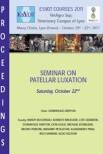Objective: To describe the short-term outcome of acute arthroscopically assisted ulnar shortening (AUS), to treat short radius syndrome in dogs.
Study design: Case series.
Animals: Eleven client owned dogs.
Methods: Records of dogs that had undergone AUS for treatment of short radius syndrome were reviewed for inclusion. Reporting data included among others pre- and postoperative radioulnar, humeroradial and humeroulnar distances, lameness scores, surgical times, complications and clinical outcome.
Results: Following AUS, radiohumeral articulation was improved in all dogs. Median presurgery radioulnar, humeroradial and humeroulnar values were 4.5, 3.2, and 2.2 mm and were improved with surgery by a median of 3.2, 1.8, and 1.2 mm, respectively. Median surgery time was 140 min. Median time to bone healing was 8 weeks (range: 4-14). Median time to last follow-up was 9 weeks (4-468). Median lameness score (scale 0-4) improved from 2 to 1. No major complications were reported. Short-term clinical outcome was graded by the surgeons as full function in four cases and acceptable function in seven.
Conclusion and clinical relevance: Radiographic and arthroscopic radiohumeral articulation were improved and short-term clinical improvement was documented following AUS in all 11 dogs.









